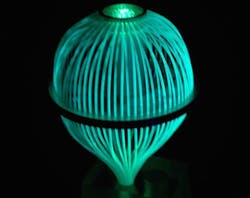Fluorescent detector for free-space optical communication is omnidirectional
Free-space optical communication offers a promising way to bring the internet to remote areas where optical fibers and cell towers are challenging to deploy in a cost-effective way. Using laser light to wirelessly carry information can potentially offer very high bandwidths and data capacity; however, one of the primary challenges has been how to precisely point a very small laser beam carrying the data at a small light detector that is some distance away.
Researchers from Facebook's Connectivity Lab have demonstrated a conceptually new approach for detecting free-space optical communication signals in which fluorescent materials collect light and concentrate it onto a small photodetector.1 They combined this light collector, which features 126 cm2 of surface that can collect light from any direction, with existing telecommunications technology to achieve data rates of more than 2 Gbit/s. The setup, which operated at an eye-safe intensity, replaces the classical optics and motion platform typically required to point the light to the collection area.
Omnidirectional reception
“We demonstrated the use of fluorescent optical fibers that absorb one color of light and emit another color,” said Tiecke. “The optical fibers absorb light coming from any direction over a large area, and the emitted light travels inside the optical fiber, which funnels the light to a small, very fast photodetector.”
The new light collector uses plastic optical fibers containing organic dye molecules that absorb blue light and emit green light.
"The fact that these fluorescent optical fibers emit a different color than they absorb makes it possible to increase the brightness of the light entering the system," says Tiecke. "This approach has been used in luminescent concentrators for solar light harvesting, where the speed of the color conversion doesn’t matter. We showed that the same concept can be used for communication to circumvent pointing and tracking problems while accomplishing very high speeds."
The fast speeds are possible because less than 2 ns lapse between the blue light absorption and the green light emission. By using orthogonal frequency division multiplexing (OFDM), the researchers transmitted more than 2 Gbit/s despite the system’s bandwidth of 100 MHz. If implemented in the IR with other materials, the new approach could theoretically allow free-space optical data rates of more than 10 Gbit/s.
Source: http://www.osa.org/en-us/about_osa/newsroom/news_releases/2016/new_detector_from_facebook_s_connectivity_lab_over/
REFERENCE:
1. T. Peyronel et al., Optica (2016); doi: 10.1364/OPTICA.3.000787

John Wallace | Senior Technical Editor (1998-2022)
John Wallace was with Laser Focus World for nearly 25 years, retiring in late June 2022. He obtained a bachelor's degree in mechanical engineering and physics at Rutgers University and a master's in optical engineering at the University of Rochester. Before becoming an editor, John worked as an engineer at RCA, Exxon, Eastman Kodak, and GCA Corporation.
